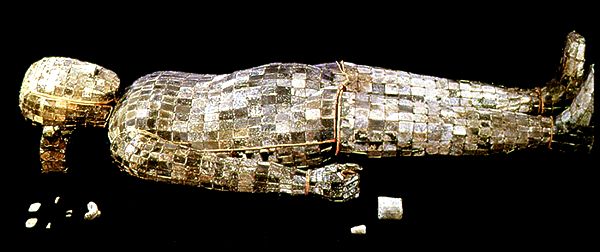
A Golden Age for San Francisco's Asian Art Museum
By Kathy Nguyen
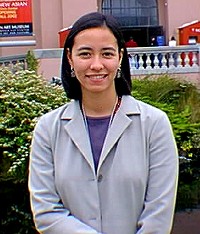
"The title [of the exhibit] refers to the last 50 years since the founding of the People's Republic of China in 1949, and commemorates the government's highest achievements during that time," said Pauline Yao (right), assistant curator of the Asian Art Museum.
It took researchers nearly six years to organize the exhibition, which is one of the grandest displays of ancient Chinese art ever presented in the United States. Dr. Yang Xiaoneng, curator of the Nelson Atkins Museum in Kansas City and the exhibition's chief organizer, worked with numerous government officials and curators from both the U.S. and China to bring together the artifacts, which come from over 30 museums in China. The Golden Age exhibition opened at the National Gallery of Art in Washington D.C. and went to the Houston Museum of Fine Arts before coming to the Asian Art Museum of San Francisco, its final U.S. destination.
Commenting on the scope and historical significance of the exhibit, Emily Sano, director of the Asian Art Museum, said, "The important objects included in the exhibition reflect great achievements in Chinese archaeology. The study of these works has made possible the reconstruction, in far greater detail than ever before, of the cultural meaning of ancient works of art in their own time."
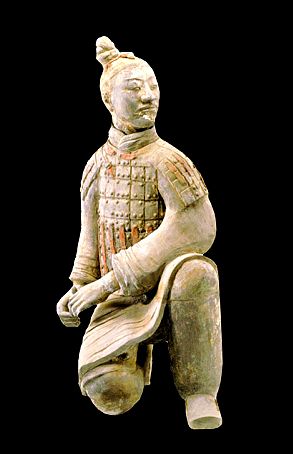 The
first monumental archaeological discoveries were made during the 1970s.
In 1974, farmers digging a well in the city of Xi'an uncovered clay fragments
of sculpted human figures. Archaeological excavations confirmed that the
site contained the tomb of the first emperor of the Qin dynasty, who was
buried in 210 BCE. The tomb, which consisted of four pits approximately
16-feet deep, contained 7,000 terra cotta soldiers, horses and chariots
designed to guard the emperor in the next life. Several of these life-size
figures, including cavalrymen and horses, a high-ranking officer and kneeling
archer (left ) -- all of which have been remarkably preserved --
are featured in the exhibit. Archaeologists are still waiting to excavate
the fourth pit in which the emperor himself was buried.
The
first monumental archaeological discoveries were made during the 1970s.
In 1974, farmers digging a well in the city of Xi'an uncovered clay fragments
of sculpted human figures. Archaeological excavations confirmed that the
site contained the tomb of the first emperor of the Qin dynasty, who was
buried in 210 BCE. The tomb, which consisted of four pits approximately
16-feet deep, contained 7,000 terra cotta soldiers, horses and chariots
designed to guard the emperor in the next life. Several of these life-size
figures, including cavalrymen and horses, a high-ranking officer and kneeling
archer (left ) -- all of which have been remarkably preserved --
are featured in the exhibit. Archaeologists are still waiting to excavate
the fourth pit in which the emperor himself was buried.
"The Chinese archaeologists are very concerned about excavating the emperor's tomb in the proper way, and according to certain rites," explained Yao. "It's also crucial to have the right equipment so that everything can be preserved correctly."
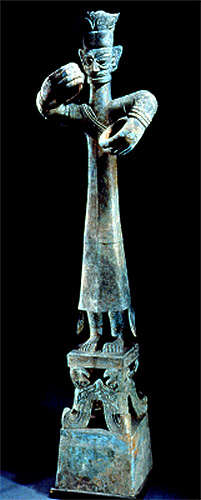 Since
the death of Mao Zedong in 1976, Chinese leaders have sped up processes
to redevelop and modernize the country. As a result, large tracts of land
and ancient burial sites were excavated so new structures could be built.
These digs continue to yield significant findings that force scholars
to rethink China's history. But rather than making any definitive statements
about ancient Chinese civilization and culture, The Golden Age exhibit
poses a flurry of questions for both researchers and non-specialists alike.
For example, the symbolic significance of a 3,000-year-old, eight-foot
standing bronze figure (right) that may have once held an elephant tusk
in its grip, remains a mystery. Until the mysterious figure was discovered
in a sacrificial pit in Sichuan province in 1986, no life-size sculpture
was believed to have existed from China's Bronze Age. The terra cotta
warriors made 1,000 years later are the next earliest examples of life-size
figures.
Since
the death of Mao Zedong in 1976, Chinese leaders have sped up processes
to redevelop and modernize the country. As a result, large tracts of land
and ancient burial sites were excavated so new structures could be built.
These digs continue to yield significant findings that force scholars
to rethink China's history. But rather than making any definitive statements
about ancient Chinese civilization and culture, The Golden Age exhibit
poses a flurry of questions for both researchers and non-specialists alike.
For example, the symbolic significance of a 3,000-year-old, eight-foot
standing bronze figure (right) that may have once held an elephant tusk
in its grip, remains a mystery. Until the mysterious figure was discovered
in a sacrificial pit in Sichuan province in 1986, no life-size sculpture
was believed to have existed from China's Bronze Age. The terra cotta
warriors made 1,000 years later are the next earliest examples of life-size
figures.
"We're using new strategies for this exhibit to better engage the audience," said Yao. "Instead of presenting only a summary of the history behind the objects on display and providing all the answers, we've also posed a series of questions to stimulate people's intellectual curiosity. It's a new way to get people to become more interested in the art."
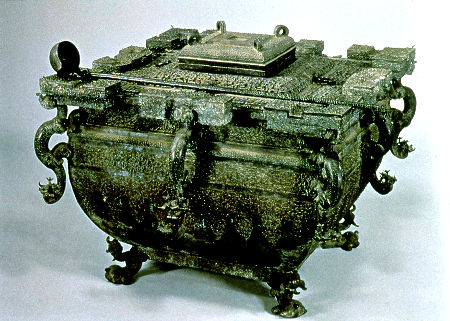 Some
of the most fascinating artifacts on display, such as bronze vessels for
pouring and heating wine and cauldrons for steaming food, come from the
tombs of wealthy aristocrats. One particularly remarkable item in the
exhibit is a Shi Qiang bronze basin belonging to the aristocratic Wei
family of the Western Zhou dynasty (mid 1000s-771 BCE). The large vessel
(see above) is engraved with lengthy inscriptions extolling the virtues
of the Zhou kings and four generations of the Wei family. Yet perhaps
the most stunning pieces from early imperial China are two magnificent
burial shrouds (top of page) from the Han dynasty made entirely of jade
plaques knotted together with gold wire. All of the pieces are awesome
representations of a rich cultural past and give new insight into our
understanding of Chinese history.
Some
of the most fascinating artifacts on display, such as bronze vessels for
pouring and heating wine and cauldrons for steaming food, come from the
tombs of wealthy aristocrats. One particularly remarkable item in the
exhibit is a Shi Qiang bronze basin belonging to the aristocratic Wei
family of the Western Zhou dynasty (mid 1000s-771 BCE). The large vessel
(see above) is engraved with lengthy inscriptions extolling the virtues
of the Zhou kings and four generations of the Wei family. Yet perhaps
the most stunning pieces from early imperial China are two magnificent
burial shrouds (top of page) from the Han dynasty made entirely of jade
plaques knotted together with gold wire. All of the pieces are awesome
representations of a rich cultural past and give new insight into our
understanding of Chinese history.
The Golden Age exhibit ends in September. Upcoming exhibitions at the Asian Art Museum include: "Between the Thunder and the Rain: Chinese Paintings from the Opium War to the Cultural Revolution" (October 25-January 14, 2001), featuring traditional ink and color paintings, hanging scrolls and fans; "Taoism and the Arts of China" (February 21-May 13, 2001) organized by the Art Institute of Chicago, which will focus on arts created around Taoism such as paintings, sculpture, ceramics, calligraphy, teachings, scrolls and texts; "Spirit of Zen: Paintings and Calligraphy from the 17th through the 20th Century" (June 27-October 7, 2001) featuring dramatic ink brushwork created by famous Zen monks; and "Empire of the Sultans: Ottoman Art from the Khalili Collection" (August 1 - October 7, 2001) presenting Islamic art from six centuries of the Ottoman Empire and including armor, textiles and manuscripts.
The Asian Art Museum also houses permanent regional collections for China, The Himalayas, India, Iran, Japan, Korea, Thailand, Vietnam, Cambodia, Laos and Burma. With over 13,000 art objects representing the different countries and cultures of Asia, it is the largest museum devoted to Asian art in the western world. San Francisco's Asian art collection, worth over $4 billion, is its second most valuable asset after real estate. Plans are well under way to transform San Francisco's historic Old Main Library in Civic Center into a new home for the Asian Art Museum, which currently occupies a dilapidated wing of the De Young Museum in Golden Gate Park. The New Asian Art Museum will be a world-class gallery designed specifically for the City's vast Asian art collection. Gae Aulenti, the Italian architect who designed the award-winning Musée d'Orsay in Paris, is heading the architectural team in charge of the New Asian Art Museum project. According to museum officials, the New Asian, which is slated to open in the fall of 2002, will have 65 percent more square footage and 30 percent more gallery space.
No doubt the New Asian Art Museum will soon embark on a golden age of its own.
Asian
Art Museum of San Francisco
Golden Gate Park, SF CA 94118
(415) 379-8800
www.asianart.org
Hours:
Sat. 9:30-9:00, Sun. 9:30-5:00
Mon. Closed, Tues./Wed. 9:30-5:00, Thurs./Fri. 9:30-9:00
Adults $7,12-17 $4, Children Free